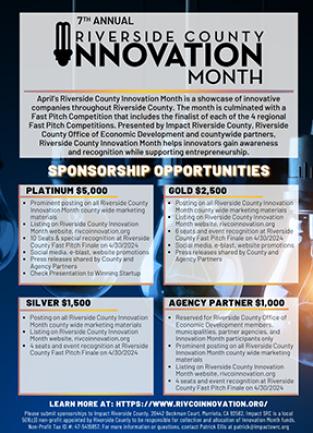Riverside County Claims its Place on the Innovation Map
April 14, 2022
Throughout its history, Riverside County has been a home to innovators. It was within the County’s borders that the famous California Navel Oranges first took root, revolutionizing the citrus industry, and nearly 150 years later, innovation continues to sprout. Today, investors, visionaries and entrepreneurs are planting roots in Riverside County, giving the region a second wind as a center for innovation.
Riverside County has built an ecosystem of Innovation Centers to welcome and attract entrepreneurs and support innovation. In the last decade, these centers have helped to raise hundreds of millions of dollars for new ventures born in the County, but the potential is even greater. Last year, venture capital investment in California-based start-ups was approximately $140 million, but that activity was concentrated in Silicon Valley and Los Angeles. Riverside County is starting to see more of its share of investment, thanks in large part to its network of Innovation Centers.

The centers are also driving job growth throughout the County. Back in 2018, news first broke that the Inland Empire, which includes both Riverside County and San Bernardino County, was outpacing the nation in tech job growth. That year, tech jobs grew 3.5% in the region, leading the state and, at second place, nearly leading the nation for tech job growth. It wasn’t a fluke. According to The Center for Social Innovation at University of California, Riverside, innovation-related jobs in Riverside County have grown 74% in the last five years.
All You Need is An Idea
There are 13 Innovation Centers located throughout Riverside County. Each one operates independently, serving different industries and provides a tailored set of services—but they all have the same goal: to assist entrepreneurs pursuing an idea.
“You can just have an idea,” says Dr. Rosibel Ochoa, the Associate Vice Chancellor of Technology Partnerships at the University of California, Riverside, which oversees EPIC, an Innovation Center with a life science and technology incubators, as well as efforts tied with UCR’s Opportunities to Advance Sustainability, Innovation, and Social Inclusion (OASIS) and the California Air Resources Board (CARB), which supports research and vehicle emissions testing. “You can come into the center as early as you want.” EPIC offers mentorship, education and training to help entrepreneurs find value in an idea and ultimately commercialize that idea, according to Ochoa. Since opening its doors five years ago, EPIC has helped more than 600 ventures and launched 46 companies. In the last three years, the center has raised more than $70 million in venture capital for start-ups.

Edge Sound Research is one of the more recent companies EPIC has helped. Founded by Valtteri Salomaki and Ethan Castro in 2020, the firm created Experiential Audio, a new audio format that allows listeners to hear and feel sound. Edge has already raised $230,000, and will start raising $4 million in SEED funding this year. “We had support from EPIC, SBDC and Riverside County, which was supporting the facilities that we were in. That allowed us to have the time and the resources to prototype and try and fail, fail, fail. It was a fertile ground to cultivate a new idea. I don’t think you get that most other places,” says Castro about his experience with EPIC.
The Coachella Valley has three Innovation Centers, also known as ihubs, operated by The Coachella Valley Economic Partnership (CVEP). “Our programs are open to any entrepreneur with a presence in the Coachella Valley and occasionally to those with a verified intent to relocate their business to the Coachella Valley,” says Laura E. James, VP of Innovation at CVEP.

The Murrieta Innovation Center (MIC) is another central hub supporting innovation in the County. The MIC has helped launch companies like Vinduino, an agronomy technology company that helps farmers manage crops through climate change. Reinier van der Lee, the CEO and founder, initially connected with the Innovation Center through a local pitch competition, but he credits the center with helping to support and scale the business. “It helps us sharpening our tools by organizing pitch competitions and soliciting investor feedback,” he says.
The California Baptist University also operates an Innovation Center to support business development in Riverside. “I am so excited to see the level of innovation happening in Riverside County,” says Tim Gramling, LPD, Assistant Professor of Business Dean of School of Business. “My role is to be the chief champion for business in the Inland Empire, particularly from a biblical and Christian worldview. Our mission is to focus on the way that business is done.”
Innovation Centers provide direction and guidance to novice entrepreneurs, who often don’t know the first step toward bringing their idea to fruition. “The world is full of individuals who are ready to pounce on naïve or starry-eyed startup founders who aren’t sure which way to turn,” says James. “There are so many free and low-cost resources in Riverside County that are available to help. Seek them out.”
Finding New Sources of Capital
Securing capital is among the most important milestones for these businesses. Historically, this has been a challenge for Riverside-based start-ups. “Access to capital is the number one challenge that we face in the region; coastal cities capture a lot of early stage funding,” says Dr. Ochoa—but the Innovation Centers are making strides to change that. EPIC has helped local start-ups raise $70 million in the last five years, and CVEP has raised $33 million in the last decade.
At EPIC, Ochoa is helping to increase access to capital through local investment. The center has launched the Highlander Venture Fund and Riverside Angels Summit to support seed funding for emerging start-ups. This is a critical benefit of the program. “As a founder, I can use all the help and advice that I can get,” says van der Lee of Vinduino. “Riverside County does not have a mature investor network, but [they are] definitely working on it.”
Venture capital is only one source of funding, and while tracking VC investment is one way to track innovation, Ochoa says that most companies don’t secure VC money. “Less than 5% of companies raise venture capital,” she says. “We need to think of all of the ways that we can facilitate access to capital for the companies that we support.” Debt is one option, although most lenders generally need collateral, but there isn’t currently a model to collateralize intellectual property. Moreover, many lenders want some incoming revenue to underwrite the loan. That has made securing debt nearly impossible for early-stage start-ups.
This is why raising local capital has become so critical to supporting business growth in the County—and it is pretty easy to understand the importance of investing in innovation. It drives economic growth and allows modern communities to thrive. “These innovation centers and innovation hubs exist because fostering entrepreneurship is a proven economic development strategy,” says James. “They mitigate many of the risks associated with starting a business and therefore encourage more people to do so.”
Of course, supporting business formation is a top economic development priority in Riverside County. Riverside County’s Office of Economic Development works closely with Innovation Centers and the local business community to create an ecosystem that ensures innovators will thrive. The County’s strength is rooted in these partnerships, which is why more and more entrepreneurs are finding support and growing in Riverside County






